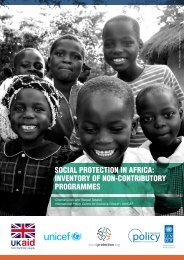https://goo.gl/sZ7V7x
293g79C
293g79C
Create successful ePaper yourself
Turn your PDF publications into a flip-book with our unique Google optimized e-Paper software.
Eligibility criteria<br />
Eligibility reassessment<br />
(if any)<br />
Type of benefits<br />
Amount of benefits<br />
Payment/delivery frequency<br />
Benefit delivery mechanism<br />
Benefit recipient<br />
Minimum and maximum<br />
duration of benefits<br />
(if any)<br />
Coverage<br />
The 10 per cent Inclusive Scheme targets the 10 per cent poorest<br />
incapacitated and destitute households in the communities under this scheme.<br />
The CGP targets households with at least one child under<br />
the age of five or a child with disabilities under the age of 14.<br />
The MCT scheme targets households satisfying one of the following conditions:<br />
a) households headed by women with at least one orphan;<br />
b) households headed by an elderly person with at least one orphan; or<br />
c) households with at least one member with disabilities.<br />
The Social Pension Scheme targets individuals who are 65 years and older.<br />
The Harmonised Inclusive Model eligibility criteria include:<br />
• residency: the household must have been living in the same<br />
catchment area for at least six months;<br />
• incapacity: the household does not have any fit-to-work members;<br />
or has a high dependency ratio (equal or greater than three); and<br />
• welfare: the household’s estimated welfare must be below a certain pre-determined<br />
threshold based on the Household Living Conditions Index in the country. Welfare<br />
levels are estimated by the Social Cash Transfer Management Information System<br />
(MIS) using information collected from households. The purpose of this criteria is<br />
to ensure that well-off households are not included in the programme. 2<br />
For the districts involved in the 2016 scale-up, the programme changed the<br />
incapacity criterion to cover all households with an elderly member aged 65 years<br />
and above or households with a person with severe disabilities, while residency<br />
and welfare tests remain the same. 1<br />
Retargeting every three years<br />
Cash<br />
Beneficiary households are entitled to ZMW70 per month,<br />
which they receive on a bi-monthly basis as a sum of ZMW140.<br />
Beneficiary households with persons with severe disabilities<br />
receive double the amount (i.e. ZMW280). 1<br />
Bi-monthly<br />
The payments are made manually by appointed Pay-Point Managers at<br />
selected pay points within the community (usually schools or rural health centres). 1<br />
The main recipient is a pre-identified member of the household (preferably female)<br />
who receives the payment on behalf of the household. 1<br />
Households continue to receive transfers until they exit the programme through<br />
retargeting or through dissolution of the household either through death or relocation<br />
to a district that does not qualify for the cash transfer.<br />
Using the harmonised model, the programme is expected to reach 10–15 per cent of<br />
the total Zambian population. By the end of 2015 the programme reached 180,261<br />
households or approximately 900,000 individuals (about 6 per cent of the population). 2<br />
Programme expenditure ZMW305 million or approximately USD30 million (2016),<br />
of which ZMW250 million comes from government funding. 3<br />
Institutions and<br />
Government of Zambia, Ministry of Community Development and Social Welfare;<br />
agencies involved<br />
UNICEF; UK Department for International Development (DFID); Irish Aid;<br />
Government of Finland; Government of Sweden; World Food Programme (WFP);<br />
International Labour Organization (ILO) 2<br />
Monitoring and evaluation Monthly monitoring visits at community and district level.<br />
mechanisms and frequency<br />
See the references on page 197: Social Cash Transfer Programme<br />
Social Protection in Africa: inventory of non-contributory programmes | 157



